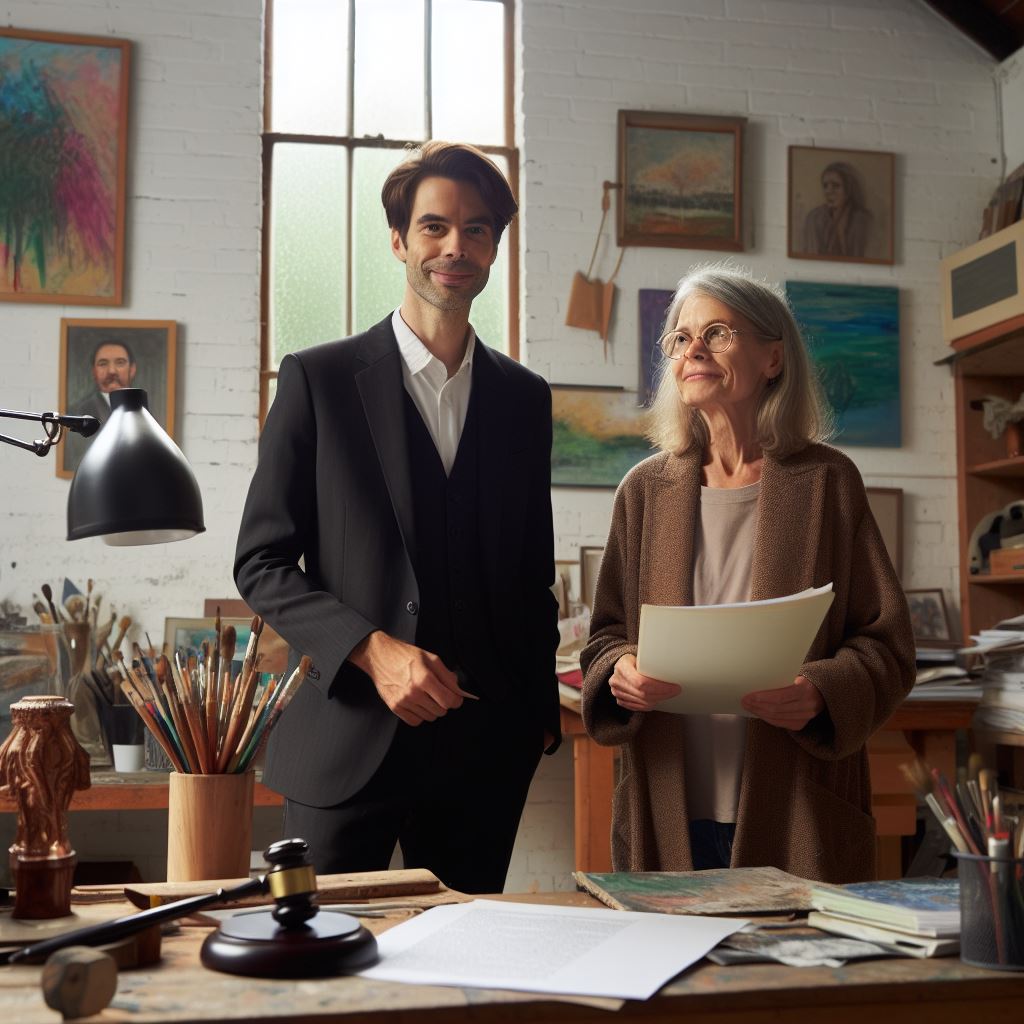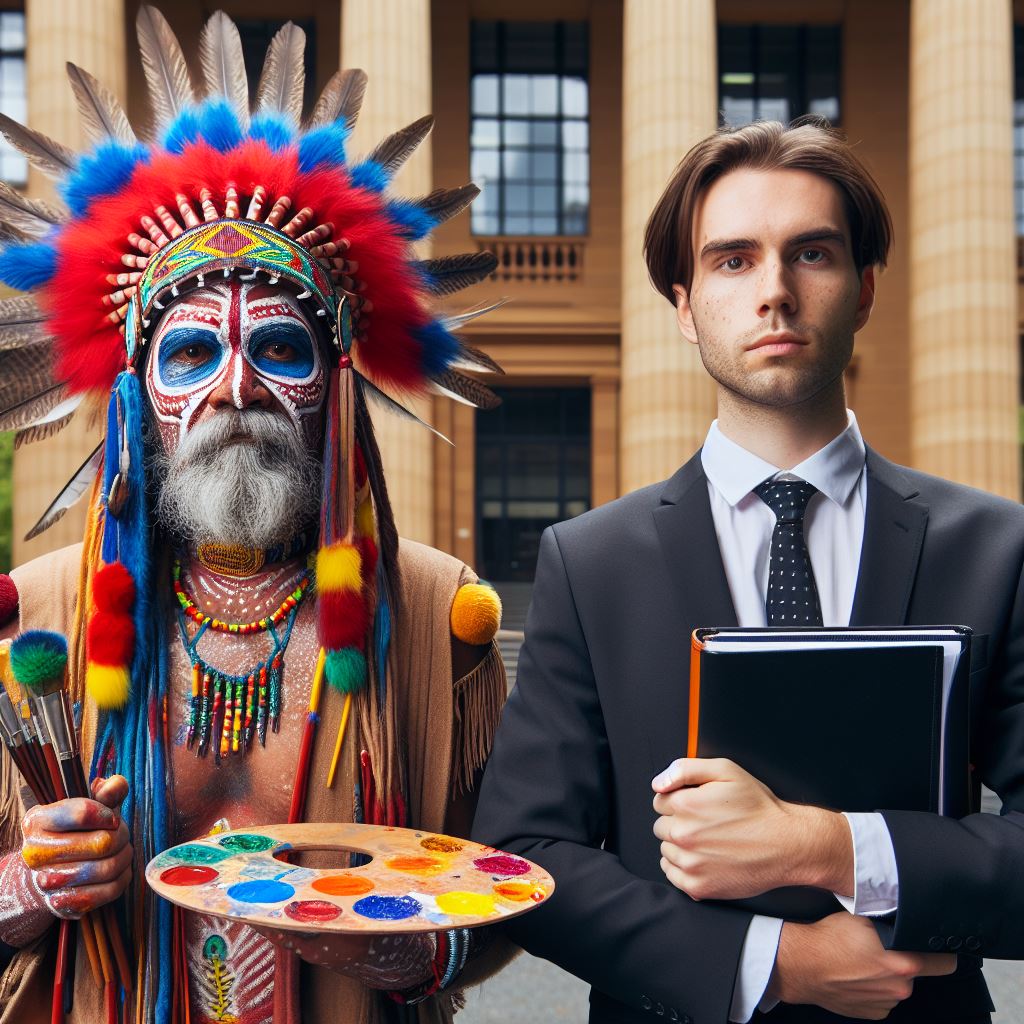Introduction
In this blog post, we will explore the relationship between Australian artists and copyright laws.
Understanding copyright laws is crucial for artists to protect their work.
Artists need to comprehend copyright laws to safeguard their creative expressions and prevent unauthorized use.
By knowing their rights, artists can ensure their work is not plagiarized or exploited without their consent.
Copyright laws provide artists with exclusive rights, including reproduction, distribution, adaptation, and public display of their creations.
Understanding these rights empowers artists to control the use and dissemination of their works.
By understanding copyright laws, artists can identify potential infringements and take appropriate action.
They can pursue legal remedies, such as cease-and-desist letters, negotiations, or even litigation, to protect their intellectual property.
Having a clear understanding of copyright laws enables artists to effectively monetize their work.
They can negotiate licensing agreements, sell reproduction rights, or enter into collaborations, ensuring their artistic endeavors generate income.
Awareness of copyright laws is vital for artists to avoid unintentional infringement and legal consequences.
By respecting the copyright of others, artists can maintain ethical practices and protect themselves from legal disputes.
Artists should take precautionary measures, such as registering their work with copyright offices or using watermarks, to establish evidence of ownership.
These precautions strengthen their position in case of infringement claims.
Understanding copyright laws is essential for Australian artists to protect their creative efforts, control the use of their work, and benefit financially.
It also ensures ethical practices and safeguards against unintentional infringement.
Overview of copyright laws in Australia
Copyright is a legal protection that applies to artistic works and allows creators to control their creations. In Australia, copyright laws are governed by the Copyright Act 1968.
What is copyright?
Copyright is a form of intellectual property law that gives creators exclusive rights to their original works. It applies to various artistic creations, such as paintings, sculptures, photographs, and literary works.
Artistic works must be original and expressed in a tangible form to be eligible for copyright protection. The moment a work is created, it is automatically protected under copyright law.
Duration of copyright protection
In Australia, copyright protection generally lasts for the creator’s life plus 70 years after their death. This duration allows the creator and their heirs to benefit from their creations.
For works of joint authorship, the duration of copyright is calculated based on the life of the last surviving author plus 70 years.
Types of artistic works covered by copyright laws
Copyright laws in Australia cover a wide range of artistic works, including:
- Paintings: Original artistic creations expressed through brushstrokes and color combinations.
- Sculptures: Three-dimensional artistic works made from various materials, such as wood, metal, or stone.
- Photographs: Original images captured through various techniques, whether digital or analog.
- Literary works: Written texts, including novels, poems, essays, and scripts.
- Architectural works: Original designs and plans for buildings and structures.
- Musical compositions: Original musical works, including songs, symphonies, and soundtracks.
- Dramatic works: Original scripts and plays intended for performance.
- Artistic crafts: Handmade crafts, such as pottery, jewelry, and textiles.
These are just a few examples of the artistic works covered by copyright laws in Australia. The protection extends to any original creative expression in a tangible form.
It’s important to note that copyright protection gives creators exclusive rights, such as the right to reproduce, distribute, and publicly display their works.
Others must seek the creator’s permission before using their works in these ways, unless permitted by specific exceptions or fair use provisions.
Understanding copyright laws is essential for Australian artists to protect their original creations and ensure they can benefit from their work.
If you’re an artist, it’s recommended to familiarize yourself with the specifics of copyright laws in your country and consider registering your works with the Australian Copyright Council to strengthen your legal rights.
Basically, copyright laws in Australia provide crucial protection for artists and their creations.
By understanding the basics of copyright, including what it is, its duration, and the types of works it covers, artists can safeguard their rights and ensure they receive deserved recognition and rewards for their artistic endeavors.
Read: Ghostwriting in Australia: An Insider’s View
Rights Granted Under Copyright
Artists are granted exclusive rights under copyright laws to protect their artistic creations. These rights are essential in acknowledging and protecting the efforts and creativity put into their work.
Exclusive Rights
Artists have several exclusive rights to their creative works. These rights include:
- The right to reproduce their artistic works
- The right to distribute copies of their works to the public
- The right to publicly display their works
- The right to perform their artistic works publicly
These exclusive rights ensure that artists have control over the use and exploitation of their creations. It enables them to make decisions about how their works are used and who benefits from them.
Your Personalized Career Strategy
Unlock your potential with tailored career consulting. Get clear, actionable steps designed for your success. Start now!
Get StartedRights to Reproduce, Distribute, Publicly Display, and Perform Artistic Works
- Reproduction: Artists have the right to reproduce their artistic works. Reproduction refers to making copies or duplicates of the original work. This right prevents others from making unauthorized copies that may lead to financial loss for the artist.
- Distribution: Artists also have the right to distribute their works to the public. This right allows them to control the dissemination of their creations, whether in physical or digital form. Artists can choose the platforms and means by which their works are made available to the public.
- Public Display: Artists possess the right to publicly display their works. This includes exhibiting their art in galleries, museums, or any other public space. It guarantees that artists have control over how and where their works are displayed, ensuring that they are presented in a manner that aligns with their artistic vision.
- Performance: Artists have the right to perform their works publicly. This right covers various art forms, such as music, theatre, and dance. It grants artists control over live performances, allowing them to decide when and where their works are performed, as well as who performs them.
Importance of Obtaining Permission or Licenses
Obtaining permission or licenses for the reproduction, distribution, public display, and performance of artistic works is crucial to respecting the rights of artists and avoiding copyright infringement.
- Respecting Artists’ Rights: By obtaining permission or licenses, individuals and organizations acknowledge the artist’s exclusive rights. This demonstrates respect for their creative efforts and ensures that they are credited for their work.
- Avoiding Copyright Infringement: Unauthorized use of artistic works can result in copyright infringement. This can lead to legal consequences, including penalties and financial damages. Obtaining permission or licenses is a proactive way to prevent such infringements and protect oneself from legal issues.
- Supporting Artists: Obtaining permission or licenses also directly supports artists by providing them with opportunities for compensation. Artists rely on the income generated from their works to sustain their creative careers. By obtaining permission and paying appropriate fees or royalties, individuals and organizations contribute to the livelihood of artists and the continued production of art.
In general, artists hold exclusive rights to their creations under copyright laws. These rights include reproduction, distribution, public display, and performance.
Obtaining permission or licenses is crucial not only for respecting artists’ rights but also for avoiding copyright infringement and supporting the artistic community.
Read: Australia’s Top Literary Magazines in 2024
Exceptions and limitations to copyright
Fair dealing provisions
Fair dealing provisions allow for limited use of copyrighted material without permission or payment.
- They apply to artistic works as well.
- Examples of fair dealing include criticism, review, news reporting, and research.
- It is essential to understand what constitutes fair dealing in each specific circumstance.
Transformative use
Transformative use refers to the creation of a new work by incorporating or building upon existing copyrighted material.
- Transformative use may allow artists to use copyrighted material without infringing on the original creator’s rights.
- However, it is essential to ensure that the new work adds significant value and differs substantially from the original.
- Courts consider factors such as purpose, character, and market impact when determining transformative use.
Importance of understanding exceptions and limitations
- Artists must have a thorough understanding of specific exceptions and limitations in Australian copyright laws.
- Failure to comply with these laws can result in legal consequences, including fines and injunctions.
- By being aware of the exceptions and limitations, artists can confidently navigate the boundaries of copyright law.
In a nutshell, Australian artists need to be familiar with the exceptions and limitations to copyright in order to protect their rights and avoid legal issues.
Fair dealing provisions can allow for the use of artistic works in certain contexts, such as criticism and research. Transformative use may also provide opportunities for artists to incorporate existing material into new creations.
However, artists must ensure that their use qualifies as transformative and does not infringe on the original creator’s rights.
Understanding the specific exceptions and limitations in Australian copyright laws is crucial for artists to confidently navigate the boundaries of copyright and safeguard their artistic practices.
Read: Theatre Writing in Australia: A Primer

Copyright Infringement and Enforcement
In the world of Australian artists, understanding copyright laws is essential to protect their creative works. Copyright infringement, if not addressed, can have significant consequences for both artists and infringers.
This section explores what constitutes copyright infringement, the potential repercussions for artists and infringers, and the role of the Australian Copyright Council in enforcing copyright laws.
What constitutes copyright infringement?
Copyright infringement refers to the unauthorized use, reproduction, or distribution of copyrighted material without the owner’s permission. This includes artworks, music, literature, films, photographs, and other creative expressions.
The potential consequences of copyright infringement for artists and infringers
- Financial Loss: Copyright infringement can impact artists financially as their work may be reproduced or distributed without compensation. This deprives them of potential income and recognition.
- Reputation Damage: For artists, unauthorized use of their work can dilute their brand and professional reputation. It may lead to confusion or loss of trust among their audience.
- Legal Action: In cases of copyright infringement, artists have the right to take legal action against infringers. This may involve seeking compensation, injunctions, and damages through civil litigation.
- Criminal Penalties: In severe cases, copyright infringement can lead to criminal charges, resulting in imprisonment and fines.
Role of the Australian Copyright Council in enforcing copyright laws
The Australian Copyright Council plays a crucial role in educating artists and the general public about copyright laws and enforcing them. Their involvement includes:
- Legal Advice: The Council provides legal advice to artists, helping them understand their rights and guiding them through the process of protecting their works.
- Resources and Workshops: They offer various resources such as publications, information sheets, and workshops that educate artists on copyright protection and infringement prevention.
- Advocacy and Policy Development: The Council actively engages with government bodies and policymakers to influence copyright legislation, ensuring artists’ rights are safeguarded.
- Copyright Infringement Assistance: The Council assists copyright owners in taking appropriate legal actions against infringers, including sending cease and desist letters and negotiating settlements.
- Copyright Education: Through their comprehensive educational programs, the Council raises awareness among artists, schools, businesses, and the public about copyright laws, fostering a culture of respect for creative works.
In fact, copyright infringement poses significant risks to artists and infringers alike. It is important for artists to familiarize themselves with copyright laws, understand what constitutes infringement, and be aware of the potential consequences.
Organizations like the Australian Copyright Council play a vital role in enforcing copyright laws, helping artists protect their creative endeavors and ensuring a fair and thriving artistic landscape in Australia.
Read: Australian Poets: Voices of a Nation
Uncover the Details: Street Photography Guide for Australians
Explore Further: Mastering Light: Tips from Aussie Pros
Stand Out with a Resume That Gets Results
Your career is worth more than a generic template. Let us craft a resume and cover letter that showcase your unique strengths and help you secure that dream job.
Get HiredPractical Tips for Australian Artists
As an artist, your creations are your pride and joy. You spend countless hours perfecting your work and pouring your heart and soul into every brushstroke or note you create.
But how can you protect your work from copyright infringement? In this blog section, we will provide you with practical tips to safeguard your artistic creations and enforce your rights.
Protecting Your Work from Copyright Infringement
- Always include a copyright notice on your creations, consisting of the symbol ©, the year of creation, and your name.
- Watermark your digital artwork to deter unauthorized use and protect its integrity.
- Consider creating a limited edition of your physical artwork and number each piece, making them more exclusive and less susceptible to infringement.
- Monitor online platforms and websites regularly to identify any potential unauthorized use of your work.
- Establish strong relationships with galleries, agents, and publishers who can help protect your work and fight against infringement on your behalf.
- Consult a legal professional to draft comprehensive agreements with clients or licensees, ensuring the protection of your intellectual property rights.
Registering Artistic Works with the Copyright Office
Registering your artistic works with the Copyright Office provides you with additional legal protection and strengthens your rights. Here are the steps to follow:
- Visit the Copyright Office website and familiarize yourself with the registration process and requirements.
- Gather all necessary documentation, including high-quality photographs or digital copies of your work.
- Complete the registration application online, providing accurate and detailed information about your artistic creations.
- Pay the applicable registration fees, which may vary depending on the number of works being registered.
- Keep a record of your registration details, including the registration number and date, as proof of your ownership.
Enforcing Your Rights
If you discover that someone has infringed upon your copyrighted work, it is crucial to take immediate action. Here are some methods to enforce your rights:
- Send a cease and desist letter to the infringing party, clearly stating your ownership rights and demanding them to stop using your work.
- Consult with a lawyer specializing in intellectual property law to explore the possibility of legal action and potential remedies.
- Consider alternative dispute resolution methods, such as mediation or arbitration, to resolve the infringement issue.
- Maintain clear and organized records of your artistic creations, including drafts, sketches, and dates of creation. This documentation can serve as evidence in case of legal proceedings.
- Stay informed about any changes in copyright laws and regulations to ensure you are aware of your rights and can protect your work accordingly.
In essence, protecting your artistic creations from copyright infringement requires proactive measures and a solid understanding of your rights.
By following these practical tips, such as including a copyright notice, registering your work, and enforcing your rights when necessary, you can safeguard your artistic endeavors and continue to create with peace of mind.
Conclusion
In closing, understanding copyright laws is essential for Australian artists.
By understanding these laws, artists can protect their original artworks and ensure that their hard work is not plagiarized or stolen.
Key points discussed in this blog post include the definition of copyright, the rights it grants to artists, and the duration of these rights.
Additionally, the blog post highlighted the importance of obtaining permission and giving credit to other artists when using their work.
Australian artists should be aware that copyright protection extends to both physical artworks and digital reproductions.
It is crucial for artists to seek legal advice if they have specific concerns or questions about their work and copyright.
A lawyer specializing in intellectual property can provide guidance on the appropriate steps to take to protect their artistic creations.
Overall, artists should educate themselves about copyright laws and take proactive measures to safeguard their artistic endeavors.
By doing so, they can ensure that their original artwork is respected, and they can reap the benefits of their creativity and hard work.
Remember, understanding and respecting copyright laws is not only a legal obligation but also a way to foster a fair and thriving artistic community in Australia.
Transform Your LinkedIn for Maximum Impact
Elevate your professional brand with a LinkedIn profile that attracts recruiters, showcases your expertise, and maximizes opportunities. Stand out in your industry with a profile built for success.
Boost Profile



